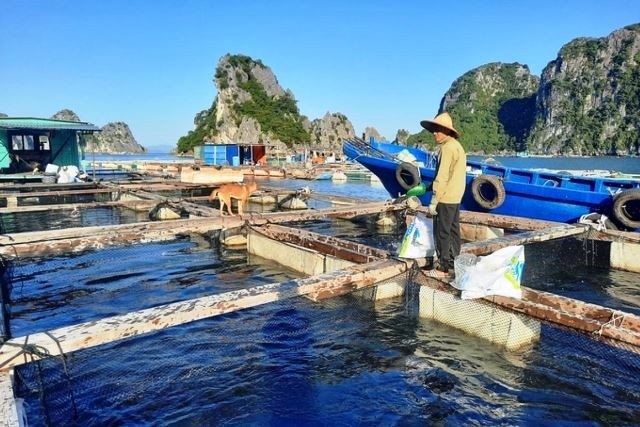(VOVWORLD) -Developing mariculture means reducing uncontrolled exploitation, protecting aquatic resources, and building a sustainable fisheries industry. To realize Vietnam’s strategy for mariculture development, the Prime Minister has approved a project on marine aquaculture development until 2030 with a vision to 2045. Quang Ninh province is a leader in mariculture development with strong achievements.
 The mariculture model in Van Don district, Quang Ninh province (Photo: dangcongsan.vn) The mariculture model in Van Don district, Quang Ninh province (Photo: dangcongsan.vn) |
Quang Ninh aims to develop a blue ocean economy, sustainably use marine resources for economic growth, improve people's livelihoods, and ensure the health of marine ecosystems rather than developing the marine economy at any cost. By promulgating development policies that increase added value and sustainability, Quang Ninh’s mariculture has achieved good results.
Aquatic production has increased from 89,000 tons in 2013 to more than 175,000 tons last year. The concentrated mariculture area has been expanded to 32,000 hectares, up more than 10,000 hectares compared to 2013.
Quang Ninh has become one of the first provinces in Vietnam to pilot a model that assigns specific sea areas to organizations and individuals for marine resource development and use in line with a Government Decree.
Cao Tuong Huy, Chairman of Quang Ninh’s provincial People’s Committee, said that Quang Ninh has planned farming areas in all coastal localities.
“This is an important basis for attracting investment. We’ve also promulgated mechanisms and policies to attract investors, especially foreign investors, encouraging them to bring all the world's advanced technologies to Quang Ninh. Based on this, the most favorable conditions will be created in assigning marine areas to locals and businesses,” said Huy.
Quang Ninh's mariculture strategy is to make specialized farmers the core of its multi-sectoral approach to achieving added value. It will take advantage of 20 million visitors annually for local consumption and export, combining aquaculture with high-tech, efficient, sustainable seafood exploitation while ensuring national defense and security.
An effort will be made to protect aquatic resources and adjust mariculture density within the three-nautical-mile zone to expand the mariculture areas in accordance with environmental planning and capacity.
STP Group, one of the enterprises engaged in efficient development of mariculture in Quang Ninh province, has combined tourism and the intercropping mariculture model while seeking foreign markets, with the goal of increasing the value on each hectare of farming area.
Nguyen Thi Hai Binh, the STP Director General, said her group is intercropping cartilage seaweed with bivalve species and with pearls. She added, “We are doing multi-layer farming, using a floating cage system. In this ecosystem, we’ll increase the value of each hectare. The value of products exported to the US, Japan, and Australia will increase 200-300%.”
 Cao Tuong Huy, Chairman of Quang Ninh’s provincial People’s Committee (Photo: nhandan.vn) Cao Tuong Huy, Chairman of Quang Ninh’s provincial People’s Committee (Photo: nhandan.vn) |
According to Tran Dinh Luan, Director of the Directorate of Fisheries at the Ministry of Agriculture and Rural Development, sustainable mariculture helps farmers stabilize their lives.
“Quang Ninh is determined to review and adjust cage density and farming area, and re-plan the farming areas which have been set up without planning’” said Luan, adding, “The province has issued standards on farming materials and applied advanced technology, and has assigned sea areas to specific organizations and individuals for marine resource development and use. Other localities can do the same.”
Mariculture has been identified as a spearhead economic sector in Quang Ninh’s development strategy, while the Government mariculture project considers Quang Ninh a national mariculture center, according to Nguyen Xuan Ky, Secretary of the provincial Party Committee.
Quang Ninh has planned 45,000 hectares of coastal areas for mariculture development, with a comprehensive approach to modernity, high-tech, environmental friendliness, added-value, and sustainability, in combination with conservation of aquatic resources, development of tourism, services, and industry, and defending maritime and island sovereignty, said Ky.
“We attach great importance to restructuring production to match the strength of each region, increasing productivity and the quality of aquatic products, developing concentrated mariculture areas, and applying modern technology to production,” Ky noted.
The success of implementing the mariculture model in Quang Ninh has created significant changes in the quality of the natural environment, and promoted sustainable marine farming toward building new values for the Quang Ninh seafood brand.